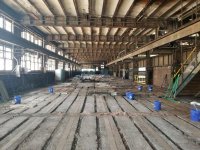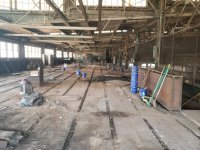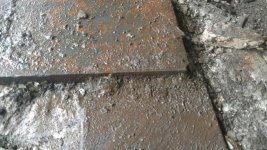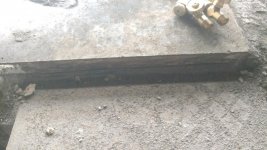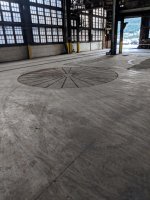TCasals
Plastic
- Joined
- Jan 20, 2018
- Location
- Concord NH
Alright good people of PM, I am at wit's end: we are in the machine shop of one of the former largest steel mills in the world. Absolutely amazing building. Each floor has 20 foot ceilings and two 10 ton cranes. At its peak, over 5000 people were said to have worked PER SHIFT in this building alone.
There must have been over 100 machines per side per floor. I know this because where each machine sat, there is a concrete pad. With a large chunk of plate inside it. Welded to larger chunks of bar stock or C channel. Which, in turn are welded to the beams that hold the floor. And let me tell you, when they say "they don't make em like they used to", they're talking about this place.
Now, between the machines used to be 2" hemlock flooring, which was removed ages ago leaving an unsuitable surface. This means we have to cut all these plates out to pour a new deck. And to put it lightly, the plates are putting up quite a fight. Turns out, the fellas that worked here did not like things falling apart, because the welds are beefy, full length stick welds with a solid 3/4" throat.
We've tried pretty much everything from demo saws to OA torches, and just can't find a way to make cutting these welds out less painful. Now, I know its probably in vain, but I figured if anyone could come up with a less hellish way for us to cut all these welds than going to town with a 9" grinder and the skinniest little discs we can find, PM seemed like the right place to look.
So please, someone, tell me there is a special weld cutting attachment for a skid steer or something that I missed, because otherwise we're gonna be at it for a looonnnggg time.
There must have been over 100 machines per side per floor. I know this because where each machine sat, there is a concrete pad. With a large chunk of plate inside it. Welded to larger chunks of bar stock or C channel. Which, in turn are welded to the beams that hold the floor. And let me tell you, when they say "they don't make em like they used to", they're talking about this place.
Now, between the machines used to be 2" hemlock flooring, which was removed ages ago leaving an unsuitable surface. This means we have to cut all these plates out to pour a new deck. And to put it lightly, the plates are putting up quite a fight. Turns out, the fellas that worked here did not like things falling apart, because the welds are beefy, full length stick welds with a solid 3/4" throat.
We've tried pretty much everything from demo saws to OA torches, and just can't find a way to make cutting these welds out less painful. Now, I know its probably in vain, but I figured if anyone could come up with a less hellish way for us to cut all these welds than going to town with a 9" grinder and the skinniest little discs we can find, PM seemed like the right place to look.
So please, someone, tell me there is a special weld cutting attachment for a skid steer or something that I missed, because otherwise we're gonna be at it for a looonnnggg time.


